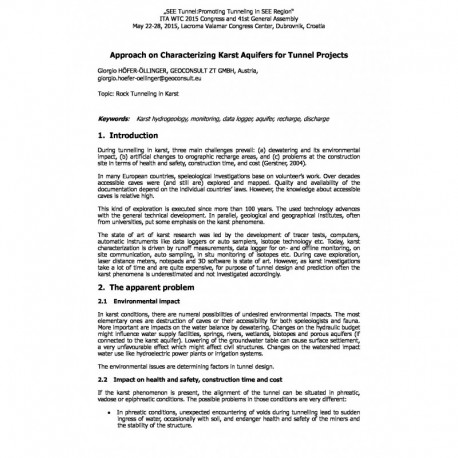Cart
0
0
No document
0,00 €
Total
Document successfully added to your shopping cart
Quantity
Total
There are 0 items in your cart.
There is 1 item in your cart.
Total documents
Total shipping
To be determined
Total
Search & filter
Search for a publication
Search & filter
Viewed documents
Approach on Characterizing Karst Aquifers for Tunnel Projects
wtc2015_full_hoefer-oellinger
During tunnelling in karst, three main challenges prevail: (a) dewatering and its environmental impact, (b) artificial changes to orographic recharge areas, and (c) problems at the construction site in terms of health and safety, construction time, and cost (Gerstner, 2004). In many European countries, speleological investigations base on volunteer’s work. Over decades accessible caves were (and still are) explored and mapped. Quality and availability of the documentation depend on the individual countries’ laws. However, the knowledge about accessible caves is relative high. This kind of exploration is executed since more than 100 years. The used technology advances with the general technical development. In parallel, geological and geographical institutes, often from universities, put some emphasis on the karst phenomena. The state of art of karst research was led by the development of tracer tests, computers, automatic instruments like data loggers or auto samplers, isotope technology etc. Today, karst characterization is driven by runoff measurements, data logger for on- and offline monitoring, on site communication, auto sampling, in situ monitoring of isotopes etc. During cave exploration, laser distance meters, notepads and 3D software is state of art. However, as karst investigations take a lot of time and are quite expensive, for purpose of tunnel design and prediction often the karst phenomena is underestimated and not investigated accordingly.




